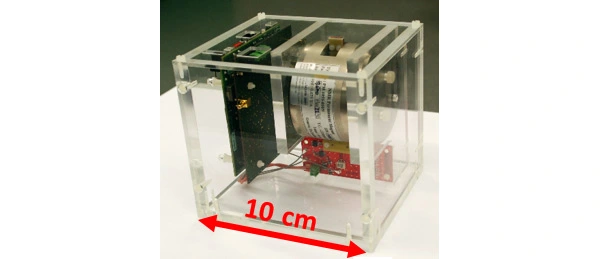Miniaturised spectrometer wins first prize at international conference
Device from Helmholtz laboratory fits a box 10 cm on a side
A Helmholtz-Zentrum Berlin (HZB) team together with experts at Ulm University and the University of Stuttgart have designed an electron spin resonance spectrometer that fits a box 10 cm on a side. The team presented the device to a technology jury at the international IEEE Sensors 2017 conference in Glasgow, Scotland and received the first prize of the best live demonstration award . ESR spectroscopy is extremely useful for research in energy-related materials such as catalysts, solar cells, and battery electrodes.
Electron spin resonance (ESR) spectroscopy is a fantastic method for studying materials. It provides information about their chemical and physical properties by first exciting the tiny elementary magnets (called spins) generated by the unpaired electrons present in chemical radicals and defects in semiconductors for exampleand then sensing the resulting magnetic fields. This can be used to determine the concentration of ”free radicals” in the blood that can trigger diseases or in the skin that can accelerate cellular aging, for example. ESR spectroscopy is not only employed in biophysics and medical diagnostic procedures though – it also helps to advance the research in energy-related materials such as catalysts, battery electrodes, and solar cells.
Conventional ESR spectrometers: a whole room needed for the apparatus
However, ESR spectrometers are usually large and expensive devices that require a lot of space and consume a great deal of energy during operation. This is because conventional ESR spectrometers work with a large electromagnet. In order to make measurements, the sample is placed inside the apparatus and excited with microwaves of a fixed frequency while the applied magnetic field is slowly varied. The sample absorbs the microwave radiation at very specific magnetic field strengths, from which the concentration of excited molecules in the sample as well as their energy states can be determined with extreme precision.
ESR on a chip: mere centimetres
Now an HZB team together with experts at Ulm University and the Univ. of Stuttgart have designed an electron spin resonance spectrometer that fits a box 10 cm on a side. Following a successful demonstration before a technology jury at the big international IEEE Sensors 2017 conference in Glasgow, Scotland, the team received first prize for its sensational device in the Live Demonstration Award competition. The spectrometer they developed is not only tiny, it also consists of a custom-designed and economical detection chip along with very economical standard components, and works with a small battery as its energy source.
Instead of the awkwardly large electromagnet, a small permanent magnet the size of a hamburger generates a constant field of 0.5 tesla. The correspondingly higher frequency necessary for the microwave radiation is achieved with a custom-designed microchip only one square millimetre in size that simultaneously acts as the ESR detector. The burger-sized “ESR-on-a-chip” detector as well as the accompanying electronics were designed by Prof. Jens Anders at Ulm University. Following his appointment to full professor at the University of Stuttgart, Prof. Anders and his team are working on further improvements in order to make the ESR technology available to a broader group of users in the future.
“With a conventional ESR spectrometer, the sample is placed inside the apparatus. But with this novel microchip, you could place the probe in the sample to investigate tumour cells in the body, for example”, explains Prof. Klaus Lips, who co-developed the device in the EPR Lab at HZB in Berlin.
“We are enormously pleased to have won first place in the demonstration session of the IEEE Sensors 2017 with our “ESR-on-a-chip” technology, not to mention that HZB has all of the important patents for future applications”, says Lips. “We have already received offers from leading manufacturers interested in licensing.”
Live Demonstration: A VCO-based point-of-care ESR spectrometer, B. Schlecker, A. Chu, J. Handwerker, S. Künstner, M. Ortmanns, K. Lips und J. Anders.
Contact
Helmholtz-Institut Berlin für Materialien und Energie
Prof. Dr. Klaus Lips
Institute Nanospectroscopy
Tel.: (030) 8062-14960
Fax: (030) 8062-15074
Email: lips(at)helmholtz-berlin.de
